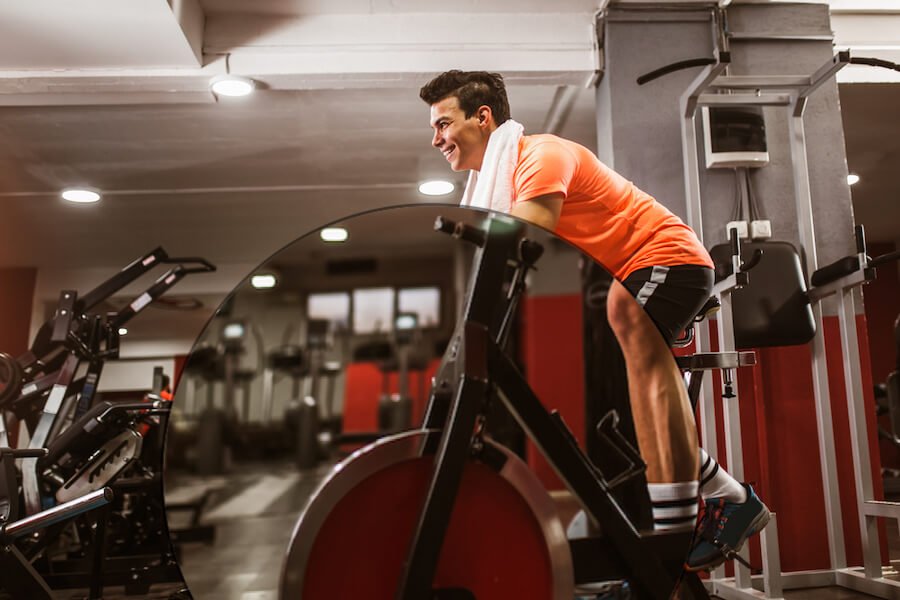Table of Contents
Introduction
When you buy a spin bike, you may come across some different flywheels and some options that you may not know what they mean. Flywheels are the centerpiece of any exercise bike. They are the big round disc-shaped metal unit that triggers how hard it is for you to cycle. They are the main piece of the exercise bike.
What is a Flywheel of a Spin Bike?
As we mentioned briefly in the introduction, the flywheel of a spin exercise bike is the centerpiece of any bike. They are the mechanical, metal wheel that spins around when you pedal on your bike. The flywheel itself is usually made out of metal and is commonly a ‘perimeter-weighted wheel that gives it more momentum when moving. You are also able to get center-weighted flywheels for extra strength, which we will cover later on in this article.
The flywheel is connected to the two pedals that then rotate the wheel by way of chain, belt, or magnets. All of these variations will power your workout when using a spin bike.
Why does the weight of the flywheel matter?
Many people often question why the weight of the flywheel matters. There are several weights and styles and even positions that you can have the flywheel in to make a major difference in your spin bike exercise.
Bigger isn’t always better, and the weight of the flywheel matters. As we know with basic physics, the heavier an object the more force and power need to be exerted to get it moving. A heavier flywheel is the same. Even though you are peddling, the energy you need to move the flywheel to start with is much greater if you were to use a lighter flywheel.
With this being said, the weight of the flywheel doesn’t necessarily mean you’ll burn more or fewer calories. Just like an outdoor bike, building up the momentum and peddling with the momentum can keep you are a steady pace, it is just the start where the most energy is consumed.
If, however, you are looking for a bike that is easy to start and more for long exercises then getting a lighter flyweight will help you keep up your pace and start will be much easier than if you were to use a heavier one. Take this into consideration if you are wanting to go for longer, rather than harder.
With all the above considered, if you are wanting a more challenging exercise, the weight of your flywheel should be a heavy one, but don’t expect it to help you burn calories faster. This will of course help, but it will be little amounts, and often slow.
Front Flywheel vs Rear Flywheel on a Spin Bike
If you’ve been looking for a spin bike for a while now, you may have noticed that some bikes have a front flywheel or a rear flywheel and in very rare cases, a dual-flywheel system (interchangeable). If you’re new to spin bikes, there are no real benefits visible when first looking at this, however, there are some benefits to both of these wheels that might be better for your spin bike experiences.
Although unlikely, a lot of the comparisons that make a rear flywheel safer and stronger are to do with the mechanics of the system. In many cases, when using a spin bike for prolonged periods, sweat can often build upon the user and fall to the ground. Front-flywheel systems are often right in the sweat buildup zone, and the sweat that falls can leave long-lasting impressions on the flywheel.
1. Liquid Resistance
Although now uncommon, many flywheels are coated in zinc which prevents rust buildup, but constant grinding against the flywheel and leads to this coat being vulnerable and therefore not being able to do the job it’s supposed to. Sweat can oxidize the metal and rust may occur should it find itself there. This is uncommon, and usually after months or even years of usage, but is still something you should consider when buying your spin bike flywheel. Rear-flywheel bikes don’t see any (or much) sweat as the fall zone is usually forward and not behind you.
2. Maintaining the Flywheels
Similarly, to the above, rear-flywheels are also a lot easier to maintain. For example, many spin bike manufacturers suggest wiping down the flywheels for any liquid on the flywheels, which means you need to get down on your knees and wipe the flywheel dry which can be a workout in itself. As rear-flywheels don’t usually get any liquids on them, maintaining it can be a lot easier.
3. Riding Difficulty and Experience
Many people believe that having a front-flywheel is harder as you’re seeing the progression of the wheel spinning, but this is more of a phycological effect than a physical one. There has been no proof of both a front-flywheel being more physically demanding than a rear-flywheel.
However, some bikes feature a lighter wheel on the back, yet the user experience is enhanced. Whilst heavier wheels are to be more physically demanding, rear-flywheels tend to be lighter by default, and are like this from some of the biggest spin bike manufacturers. For example, the Keiser M3i has a very light flywheel at the rear, yet hundreds of reviews make
With this being said, you should go with personal preference, and if you would like the motivation to spin the flywheel quicker, then a front-flywheel may be for you.
Heavy vs Light Flywheels – Detailed Comparison
When purchasing a spin bike, deciding on what kind of flywheel you want is very important and can impact your workouts for years to come when owning the spin bike. In this article, we take a look at a detailed comparison of the heavy and light flywheels and compare them to see why you may want one of the others. Let’s take a look.
Heavy Flywheel
Heavy flywheels are for the spin bike users that prefer a little bit more of a challenge. Heavy flywheels (20 lbs.+) mean you have to work a little bit harder to start with and a little bit more momentum when using it.
Heavy flywheels are often compared to the feel of a real bike with a little extra weight when starting to pedal. With this being said, you need to put a little more effort into moving the wheel to first get going. Most spin bikes are designed to allow for heavy flywheels, that give you the most realistic exercise.
In most cases, heavy or heavier flywheels often give a much smoother ride too. The heavier the flywheels that you use, gaining momentum and remaining at a similar speed will make your ride smoother due to moving at the same speed. The momentum from the weight of the wheel will help your pedals along even if you stop peddling whereas a light flywheel may just stop a lot quicker.
Here are some of the Pros and Cons of the heavy flywheel;
Pros:
- Heavy flywheels offer a smoother ride after gaining momentum.
- A more worth-while workout/exercise as more energy is required to start/maintain/stop.
- Often more budget-friendly as heavy wheels are usually easier to manufacture.
- Easier to maintain as more pressure can be applied and less wear/tear overall.
Cons:
- Stopping can be slow/forceful, something to keep in mind if your joints suffer from aches.
- Makes the bike heavier, and sometimes harder to move and or reposition.
Light Flywheels
Light flywheels are somewhat underdogs when they come to the comparison between the two wheels. Light flywheels are often overlooked as they are ‘too-easy’ and ‘too-uneven’ for a workout. Both of these facts are incorrect when you buy the right spin bike.
The vast majority of spin bike brands who have developed a decent product have designed the spin bike to utilize the light flywheels to give an even smoother ride than the heavy flywheels. Bikes that have been able to utilize the light flywheels can create a very comfortable and smooth ride, however, this is usually down to how fast (or slow) the wheel is spinning.
Here are some of the Pros and Cons of Light flywheels;
Pros:
- Lighter, and so building momentum can be done so much more efficiently
- Takes a lot less energy to start and stop, meaning less pressure on joints.
Cons:
- In most cases, lighter flywheels are more expensive.
- Wear and tear can occur a little faster than those of heavy flywheels.
Comparison
When comparing both light and heavy flywheels, some major points might be a key selling point for you.
If you are trying to buy a spin bike on a budget, getting yourself a heavier flywheel spin bike will often be a little less expensive than those with a light flywheel, but the difference isn’t always a massive one.
Another key difference is the starting, maintaining speed, and stopping of the bike. Heavier flywheels will keep your joins working and gaining momentum will be harder and more energy will need to be exerted. Lighter flywheels will help with getting started straight away, as well as less pressure on your joints when stopping.
The last comparison we want to make is for ride enjoyment. Both heavy and light flywheels can offer a smooth and long-lasting ride that is both comfortable and challenging. A heavier wheel will be better for the exercise, but both of these wheels will provide a smooth ride to keep you moving, regardless of which weight you want to choose.
What is the right Flywheel Weight for me?
If you are someone who is wanting a challenge and or feels like you need to have the real-life aspects from a bike, then a heavy flywheel may be for you. Not only will you be pushing yourself each time you start and stop, but the ride is also super comfortable and feels life-like if you were cycling on a smooth road.
However, if you are wanting to hop on your bike and just start cycling for a prolonged period of time without putting added pressure on your joints, then getting a well-built light flywheel spin bike will offer the same pleasurable ride and level of exercise.
FAQ
Here are some common questions that are asked by people who are trying to find the perfect flywheel weight for them.
Are heavy flywheels better?
Not always. Heavier flywheels can offer a harder challenge when using the spin bike, however don’t have any major benefits other than more resistance when cycling.
Does a flywheel weight matter with magnetic resistance?
When you’ve got yourself a flywheel weight that has magnetic resistance, it will still matter. You will still need to cycle to get it spinning, but the magnetic resistance will only make the cycling harder, so making sure you can pedal the weight will be important.
What is the difference between Perimeter-weighted and center-weighted flywheel?
As the name suggests, perimeter-weighted spin bike flywheels are weighted towards the outside rim of the flywheel. Center-weighted flywheels on the other hand have the weights closer to the center. The difference between the two is that because the weights on the perimeter weighted flywheel are on the outside, there will be more momentum built up when cycling. This will make for a somewhat easier cycle than that of a center-weighted flywheel.
Conclusion
In conclusion, when you buy a spin bike, the type of flywheel that you get is quite important. This guide hopefully has covered enough to help you make the right decision on what spin bike you will want to buy, and the ideal flywheel weight you want to get.

The article has been researched & compiled by the Editorial BPF Team, a group of experienced fitness & health writers.
